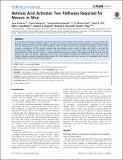| dc.contributor.author | Koubova, Jana | |
| dc.contributor.author | Hu, Yueh-Chiang | |
| dc.contributor.author | Bhattacharyya, Tanmoy | |
| dc.contributor.author | Soh, Ying Qi Shirleen | |
| dc.contributor.author | Gill, Mark E. | |
| dc.contributor.author | Goodheart, Mary L. | |
| dc.contributor.author | Hogarth, Cathryn A. | |
| dc.contributor.author | Griswold, Michael D. | |
| dc.contributor.author | Page, David C | |
| dc.date.accessioned | 2014-10-17T13:50:50Z | |
| dc.date.available | 2014-10-17T13:50:50Z | |
| dc.date.issued | 2014-08 | |
| dc.date.submitted | 2014-02 | |
| dc.identifier.issn | 1553-7404 | |
| dc.identifier.uri | http://hdl.handle.net/1721.1/90960 | |
| dc.description.abstract | In all sexually reproducing organisms, cells of the germ line must transition from mitosis to meiosis. In mice, retinoic acid (RA), the extrinsic signal for meiotic initiation, activates transcription of Stra8, which is required for meiotic DNA replication and the subsequent processes of meiotic prophase. Here we report that RA also activates transcription of Rec8, which encodes a component of the cohesin complex that accumulates during meiotic S phase, and which is essential for chromosome synapsis and segregation. This RA induction of Rec8 occurs in parallel with the induction of Stra8, and independently of Stra8 function, and it is conserved between the sexes. Further, RA induction of Rec8, like that of Stra8, requires the germ-cell-intrinsic competence factor Dazl. Our findings strengthen the importance of RA and Dazl in the meiotic transition, provide important details about the Stra8 pathway, and open avenues to investigate early meiosis through analysis of Rec8 induction and function. | en_US |
| dc.description.sponsorship | Whitehead Institute for Biomedical Research (Abraham Siegel Fellowship) | en_US |
| dc.description.sponsorship | Howard Hughes Medical Institute | en_US |
| dc.description.sponsorship | National Institutes of Health (U.S.) | en_US |
| dc.language.iso | en_US | |
| dc.publisher | Public Library of Science | en_US |
| dc.relation.isversionof | http://dx.doi.org/10.1371/journal.pgen.1004541 | en_US |
| dc.rights | Creative Commons Attribution | en_US |
| dc.rights.uri | http://creativecommons.org/licenses/by/4.0/ | en_US |
| dc.source | Public Library of Science | en_US |
| dc.title | Retinoic Acid Activates Two Pathways Required for Meiosis in Mice | en_US |
| dc.type | Article | en_US |
| dc.identifier.citation | Koubova, Jana, Yueh-Chiang Hu, Tanmoy Bhattacharyya, Y. Q. Shirleen Soh, Mark E. Gill, Mary L. Goodheart, Cathryn A. Hogarth, Michael D. Griswold, and David C. Page. “Retinoic Acid Activates Two Pathways Required for Meiosis in Mice.” Edited by R. Scott Hawley. PLoS Genet 10, no. 8 (August 7, 2014): e1004541. | en_US |
| dc.contributor.department | Massachusetts Institute of Technology. Department of Biology | en_US |
| dc.contributor.mitauthor | Koubova, Jana | en_US |
| dc.contributor.mitauthor | Soh, Ying Qi Shirleen | en_US |
| dc.contributor.mitauthor | Page, David C. | en_US |
| dc.relation.journal | PLoS Genetics | en_US |
| dc.eprint.version | Final published version | en_US |
| dc.type.uri | http://purl.org/eprint/type/JournalArticle | en_US |
| eprint.status | http://purl.org/eprint/status/PeerReviewed | en_US |
| dspace.orderedauthors | Koubova, Jana; Hu, Yueh-Chiang; Bhattacharyya, Tanmoy; Soh, Y. Q. Shirleen; Gill, Mark E.; Goodheart, Mary L.; Hogarth, Cathryn A.; Griswold, Michael D.; Page, David C. | en_US |
| dc.identifier.orcid | https://orcid.org/0000-0001-9920-3411 | |
| mit.license | PUBLISHER_CC | en_US |
| mit.metadata.status | Complete | |
